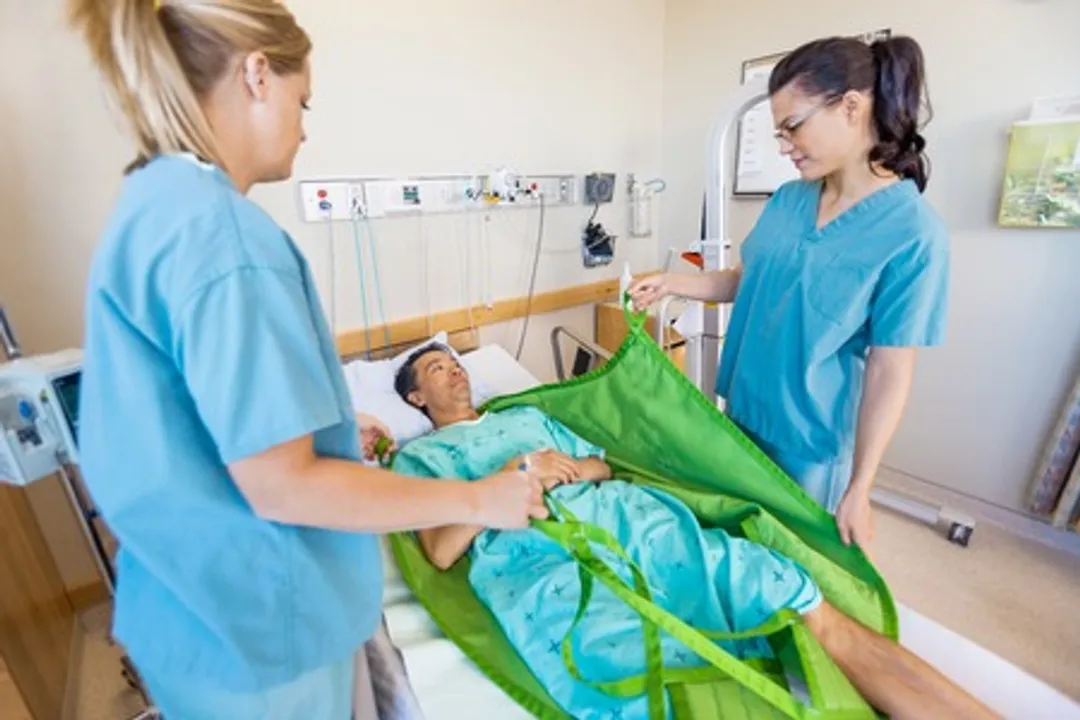Keeping Yourself Safe While Working in Healthcare

Tyler Olson/123RF.com
Put Your Mask on First
Healthcare professionals are notorious for not being very good patients, but if you want a long career in healthcare, you need to take care of yourself. As it goes with airline safety, in order to help someone who can’t help himself, you need to put your own mask on first, right?
Patient care can be challenging for many reasons. Depending on the setting in which you work, it can be very physically challenging. Per OSHA, 20% of nurses leave direct care due to the risks associated with work.
During an eight or twelve-hour shift, how much of your day is spent doing these:
- Transferring patients to a stretcher or a wheelchair? Or a toilet or shower chair?
- Helping patients roll in bed? Or scooting them up in the bed?
- Making a bed with the patient in it?
- Squatting, climbing, or bending?
- Pushing, pulling, or lifting heavy equipment or furniture?
- Working with patients who are agitated, confused, weak, heavy, or unpredictable?
- Reaching for objects over your head or out of your reach?
Those who have a less physical job are not in the clear. Are you guilty of any of these?
- Standing statically for a prolonged time?
- Sitting at a desk that’s not yours, with your feet floating in the air or your head cranked to see the screen or reaching far for the phone?
- Not sitting or standing up straight like your mama told you?
Who’s at risk?
If you have a job that involves any of the above, you could be at risk for injuring yourself at work or having work-associated aches and pains. Increase that risk if you do many of these activities over and over, are lifting too much weight, or are exerting too much force on your back. According to OSHA in 2010, nursing aides, orderlies, and attendants had the highest rate of musculoskeletal injuries. Those with less physical jobs are at risk due to their lack of activity and if they have prolonged poor posture.
What can you do to help yourself?
- Practice good patient handling techniques
- Bed Mobility
- Take advantage of those buttons on hospital beds. Raise it to the level where you don’t have to bend at your waist. Move it into reverse Trendelenburg to get the patient to the head of the bed.
- Use draw sheets for patients whose skin can tolerate it.
- Transfers
- Plan your transfer beforehand. Prepare the patient and other caregivers, lock the bed and/or wheelchair, move lines & tubes so they will not interfere.
- Be aware of any risks that certain patients may have that could make the transfer more challenging: weight bearing restrictions, weakness or paralysis, confusion or agitation or impulsivity, potential for falling or fainting, or pain or anxiety. Be ready to give those patients a little more help.
- Use the equipment you have after appropriate training. This can include gait belts, slide boards, hydraulic lifts, overhead lifts, and more.
- Bend with your knees, avoid rotation of your trunk, and keep the patient in your personal space. If patients are in a sitting or standing position, make sure to block their knees with yours, to avoid them sliding forward.
- For the patients who can help you move them, let them! Even if they only do 25% of the work, it’s better than nothing! They get a bonus of some independence and autonomy. For those who have family at the bedside, teach them how to help. They learn, you have help, and they get closer to being ready to manage their loved one at home.
- In general, don’t be a hero! If you feel you are unable to safely transfer or move a person, ask for help. Practice your good body mechanic techniques on coworkers or guinea pigs until you get more comfortable and ask for further training from seasoned colleagues.
- Bed Mobility
- Improve your posture and strength
- Be conscious of your posture
- Your posture will not change in a day. Set a timer for every two hours and consciously straighten up. Pretend that a string is hanging from the ceiling and pulling you up from the center of your head. Then increase the reminders to every hour. Soon it will become more of a habit, and your body will be able to maintain the posture longer.
- Your legs: In sitting, your feet should be flat on the ground, with your hips and knees flexed to 90 degrees. Adjust the height of your seat to accommodate this. In standing, your knees should be slightly flexed.
- Your trunk: your back should keep its natural shape – lordosis in your lumbar spine and slight kyphosis in your thoracic spine. Choose a seat that gives you low back support.
- Your arms: In sitting your elbows should gently relax on the armrests and your monitor should be an arm’s length away. Your wrists and hands should be at the level of your elbow. Anything you need frequently should be in a close arm’s reach, to avoid constant overreaching.
- Your neck: While looking at the monitor, you should not be flexed, extended, or forward. Relax your jaw while you are at it!
- Get in better physical shape
- Be conscious of the muscles that you’re not using in your daily work. And the ones that may be overstretched due to your bad postural habits. Discuss with a physical therapist what you can do to stretch tight muscles and strengthen the weak ones.
- Focus on core strengthening to help support your back.
- Participate in moderate aerobic activity (150 minutes a week) or vigorous activity (75 minutes a week) per the recommendations of the Department of Health and Human Services. This will help with your overall health and keep you at your best to help your patients or clients.
- Be conscious of your posture
What you can do to help others in your workplace?
As a trained medical professional, you can offer your own expertise and education in keeping everyone around you safe, from families to techs, and from environmental service workers to new hires. So often we hear that patient safety is everyone’s job; maybe healthcare worker safety could be everyone’s job too!
- Improve policies & procedures for patient handling techniques and training.
- Advocate for equipment that can do the lifting for you and make sure to use it properly.
- Contact those in charge of occupational health and see if they can assess your department’s ergonomics.
- Help remind your coworkers and caregivers how to keep safe. Share the load when you have challenging patients.
- Promote fitness and wellness programs for your staff.
- Encourage staff who have inactive jobs to change positions often or have a break from their seated tasks.
Hopefully these suggestions can make your daily habits a little bit safer, so you can keep yourself healthy and excel in patient care.
What do you do to keep you and your colleagues physically healthy at work?
References:
https://www.osha.gov/SLTC/healthcarefacilities/safepatienthandling.html
http://www.mayoclinic.org/healthy-lifestyle/adult-health/in-depth/back-pain/art-20044526
http://www.mayoclinic.org/healthy-lifestyle/adult-health/in-depth/office-ergonomics/art-20046169
Related Posts
